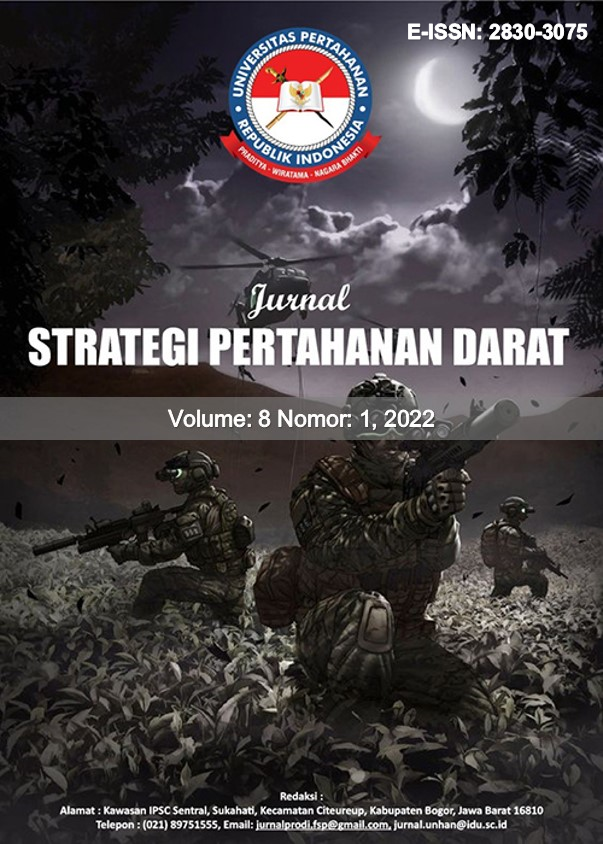STRATEGY FOR INTEGRATED LAND INFORMATION SYSTEM NETWORK ARRANGEMENTS FOR THE INDONESIAN NATIONAL ARMY
DOI:
https://doi.org/10.33172/jspd.v8i1.1054Abstract
In the era of globalization and information as it is today, and easily accessible data and information management system has become a necessity. Data and information containing ideological, political, economic, socio-cultural, and security aspects are urgently needed to manage national defense policies in order to be able to manage data and information in accordance with the interests of the system, which requires an integrated information network that can collect and manage and regulate the use of data and information. Information according to defense needs. The purpose of this study was to analyze the Strategy for Networking the Integrated Ground Defense Information System, a phenomenological qualitative research method accompanied by data collection techniques of observation, interviews, and documentation studies. The results showed that the TNI AD information system network was not well organized and not integrated where it was found that there were still ranks of the TNI AD that had not been reached by the information system network, then the number of units in the TNI AD was presented, the allocation of internet support for information system purposes was very important. The limited data transmission process, with the non-integration of the information system in the Indonesian Army, resulted in data and information being unable to be shared between data users. The conclusion from this research is that the current Information System Network Arrangement is not optimal, so the Strategy for the Integrated Ground Defense Information System Network Arrangement is carried out with a plan which includes the preparation of an information system title roadmap, the preparation of standards, and the use of independent data, the development of which includes doctrine, personnel, and structure. Organizing and strengthening Infrastructure, which includes the arrangement of LAN and WAN as well as information system network security, including background, objectives, design/methodology/approach, and results/conclusions.
Keywords: strategy, structuring, Information System Network, integrated
References
Budio, S. (2019). School Management Strategy. Journal of Organizing , 2 (2), 64.
Denzin, NK, & Lincoln, YS (2009). Qualitative Research Handbook .
Gollmann, D. (1994). Computer Security - ESORICS: Third European Symposium on Research in Computer Security Brighton, UK, 7-9 November 1994, Proceedings (Springer-V).
Halkis, M., & Haq, M. S. (2021). Phenomenology Approach in the Development of Cyber-Physical Systems (CPS) National Defense. Technium Social Sciences Journal, 17(1), 581–591. Retrieved from https://techniumscience.com/index.php/socialsciences/article/view/2552.
Indonesian National Defense Institute. (2016). Rejuvenation of Bhinneka Tunggal Ika: National Vigilance Approach. Indonesian National Defense Institute Research Journal , 25 , 1–83.
Nugroho, RB, Andreas, D., & Khaerudin. (2019). Implementation of the TNI AD Personnel Information System in Updating the Pussenarhanud Personnel Data. Journal of Information Systems , 5 (1), 43–60.
President of the Republic of Indonesia. (2021). Attachment to the Regulation of the President of the Republic of Indonesia Number 8 of 2021 concerning the General Policy of State Defense for the Year 2020-2024 (Issue Number 8, pp. 1–48).
Purwanti, A. (2013). Infrastructure Arrangement and Improvement as One of the Communication Strategies of the Batam City Tourism and Culture Office in Visit Batam. Journal of Charta Humanika , 1 (1), 1–25.
Putra, IN, & Pramono, SH (2017). Conception of Building the Strength and Capability of the Indonesian Navy's Operational Information System in Supporting the Implementation of the Archipelago Sea Defense Strategy. Asro Journal- State , 7 , 1–48.
Rahmawati, N., Swastanto, Y., Supriyatno, M., & Defense, U. (2019). Utilization of Geographic Information System Technology in Supporting the Defense System for National Vital Objects in terms of Regional Spatial Planning in DKI Jakarta Province. Journal of Sensing Technology , 1 (1), 83–95.
Ramdani, E. (2018). Business Diversification Strategy Analysis (Case Study of PT Sun Star Motor Group). Journal of the University of Putera Batam , 1 (69), 27–40.
Rifa, A. (2015). Pros and Cons of the National Security Bill. In Media Information Ministry of Defense: WIRA (pp. 20–25).
Rokhman, N. (2021). Computerized Accounting Study Program, STEKOM University. At Stekom University . http://computerisasi-acuntansi-d4.stekom.ac.id/information/baca/Sistem-Informasi-dalam-Kombinasi-Teknologi-dan-Activity-Human/371822d2fa85504960f9581cfaae6e7059bab61
Secretary of State of the Republic of Indonesia. (2004). Law Number 34 of 2004 concerning the Indonesian National Army (Issuance Number 34, pp. 1–42). http://www.dpr.go.id/dokblog/document/F_20150616_4760.PDF
Soewardi, BA (2013). The Need for Development of a Strong Cyber Defense System for Indonesia. In Defense Potential (pp. 31–35).
Sujarto, D. (2011). Introduction to Pathology . ITB Press.
Sulistyo, B., Toruan, TSL., & Waluyo, DS (2020). Dynamic Aspects of Land Defense Area Arrangement in Realizing a Layered Defense Strategy in the Province of West Kalimantan. Journal of Universal War Strategy , 6 (1), 1–26.
Utami, Y., Nugroho, A., & Wijaya, AF (2018). Strategic Planning of Information Systems and Information Technology at the Department of Industry and Manpower of Salatiga City. Journal of Information Technology and Computer Science , 5 (3), 253. https://doi.org/10.25126/jtiik.201853655

